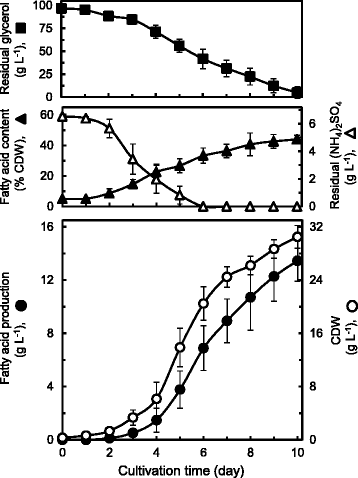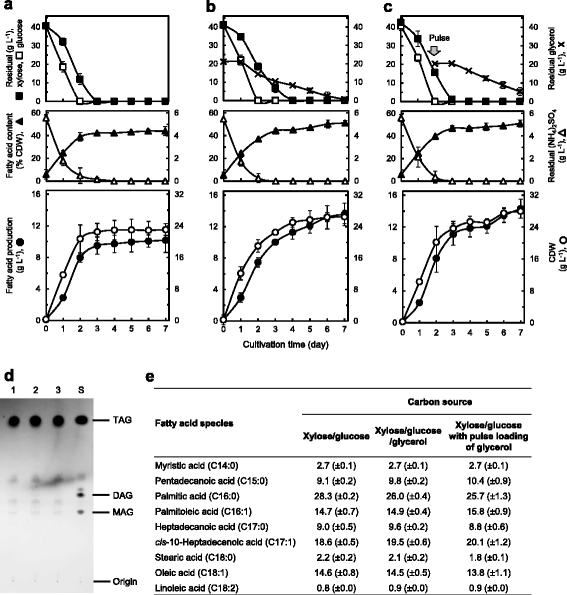Improved glycerol utilization by a triacylglycerol-producing Rhodococcus opacus strain for renewable fuels
- PMID: 25763105
- PMCID: PMC4355421
- DOI: 10.1186/s13068-015-0209-z
Improved glycerol utilization by a triacylglycerol-producing Rhodococcus opacus strain for renewable fuels
Abstract
Background: Glycerol generated during renewable fuel production processes is potentially an attractive substrate for the production of value-added materials by fermentation. An engineered strain MITXM-61 of the oleaginous bacterium Rhodococcus opacus produces large amounts of intracellular triacylglycerols (TAGs) for lipid-based biofuels on high concentrations of glucose and xylose. However, on glycerol medium, MITXM-61 does not produce TAGs and grows poorly. The aim of the present work was to construct a TAG-producing R. opacus strain capable of high-cell-density cultivation at high glycerol concentrations.
Results: An adaptive evolution strategy was applied to improve the conversion of glycerol to TAGs in R. opacus MITXM-61. An evolved strain, MITGM-173, grown on a defined medium with 16 g L(-1) glycerol, produced 2.3 g L(-1) of TAGs, corresponding to 40.4% of the cell dry weight (CDW) and 0.144 g g(-1) of TAG yield per glycerol consumed. MITGM-173 was able to grow on high concentrations (greater than 150 g L(-1)) of glycerol. Cultivated in a medium containing an initial concentration of 20 g L(-1) glycerol, 40 g L(-1) glucose, and 40 g L(-1) xylose, MITGM-173 was capable of simultaneously consuming the mixed substrates and yielding 13.6 g L(-1) of TAGs, representing 51.2% of the CDM. In addition, when 20 g L(-1) glycerol was pulse-loaded into the culture with 40 g L(-1) glucose and 40 g L(-1) xylose at the stationary growth phase, MITGM-173 produced 14.3 g L(-1) of TAGs corresponding to 51.1% of the CDW although residual glycerol in the culture was observed. The addition of 20 g L(-1) glycerol in the glucose/xylose mix resulted in a TAG yield per glycerol consumed of 0.170 g g(-1) on the initial addition and 0.279 g g(-1) on the pulse addition of glycerol.
Conclusion: We have generated a TAG-producing R. opacus MITGM-173 strain that shows significantly improved glycerol utilization in comparison to the parental strain. The present study demonstrates that the evolved R. opacus strain shows significant promise for developing a cost-effective bioprocess to generate advanced renewable fuels from mixed sugar feedstocks supplemented with glycerol.
Keywords: Adaptive evolution; Co-fermentation; Glycerol utilization; Renewable fuels; Rhodococcus opacus; Triacylglycerol.
Figures





Similar articles
-
Development of Rhodococcus opacus as a chassis for lignin valorization and bioproduction of high-value compounds.Biotechnol Biofuels. 2019 Aug 5;12:192. doi: 10.1186/s13068-019-1535-3. eCollection 2019. Biotechnol Biofuels. 2019. PMID: 31404385 Free PMC article. Review.
-
Tolerance and adaptive evolution of triacylglycerol-producing Rhodococcus opacus to lignocellulose-derived inhibitors.Biotechnol Biofuels. 2015 May 13;8:76. doi: 10.1186/s13068-015-0258-3. eCollection 2015. Biotechnol Biofuels. 2015. PMID: 26052344 Free PMC article.
-
Engineering xylose metabolism in triacylglycerol-producing Rhodococcus opacus for lignocellulosic fuel production.Biotechnol Biofuels. 2013 Sep 16;6(1):134. doi: 10.1186/1754-6834-6-134. Biotechnol Biofuels. 2013. PMID: 24041310 Free PMC article.
-
Engineering L-arabinose metabolism in triacylglycerol-producing Rhodococcus opacus for lignocellulosic fuel production.Metab Eng. 2015 Jul;30:89-95. doi: 10.1016/j.ymben.2015.04.006. Epub 2015 May 1. Metab Eng. 2015. PMID: 25936337
-
Bioconversion of renewable feedstocks by Rhodococcus opacus.Curr Opin Biotechnol. 2020 Aug;64:10-16. doi: 10.1016/j.copbio.2019.08.013. Epub 2019 Sep 30. Curr Opin Biotechnol. 2020. PMID: 31580993 Review.
Cited by
-
Systems biology and metabolic engineering of Rhodococcus for bioconversion and biosynthesis processes.Folia Microbiol (Praha). 2021 Oct;66(5):701-713. doi: 10.1007/s12223-021-00892-y. Epub 2021 Jul 3. Folia Microbiol (Praha). 2021. PMID: 34215934 Free PMC article. Review.
-
Biotechnology of Rhodococcus for the production of valuable compounds.Appl Microbiol Biotechnol. 2020 Oct;104(20):8567-8594. doi: 10.1007/s00253-020-10861-z. Epub 2020 Sep 12. Appl Microbiol Biotechnol. 2020. PMID: 32918579 Free PMC article. Review.
-
Biorefinery for Glycerol Rich Biodiesel Industry Waste.Indian J Microbiol. 2016 Jun;56(2):113-25. doi: 10.1007/s12088-016-0583-7. Epub 2016 Apr 20. Indian J Microbiol. 2016. PMID: 27570302 Free PMC article. Review.
-
Assessing the effect of temperature on Rhodococcus metabolite production.Microbiology (Reading). 2025 Aug;171(8):001598. doi: 10.1099/mic.0.001598. Microbiology (Reading). 2025. PMID: 40857076 Free PMC article.
-
Development of Rhodococcus opacus as a chassis for lignin valorization and bioproduction of high-value compounds.Biotechnol Biofuels. 2019 Aug 5;12:192. doi: 10.1186/s13068-019-1535-3. eCollection 2019. Biotechnol Biofuels. 2019. PMID: 31404385 Free PMC article. Review.
References
-
- Li C, Lesnik KL, Liu H. Microbial conversion of waste glycerol from biodiesel production into value-added products. Energies. 2013;6:4739–68. doi: 10.3390/en6094739. - DOI
LinkOut - more resources
Full Text Sources
Other Literature Sources
Miscellaneous

